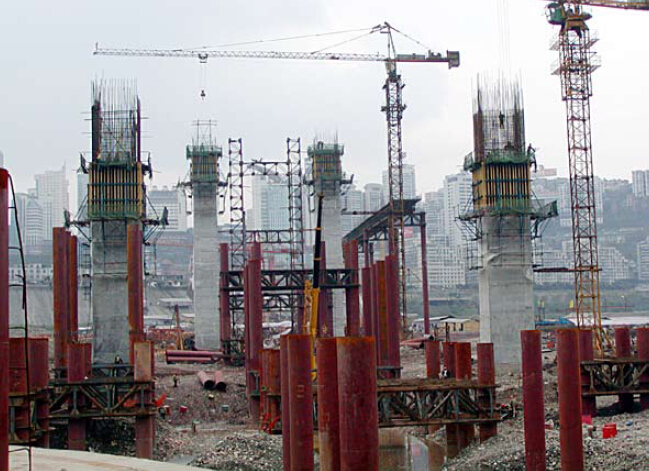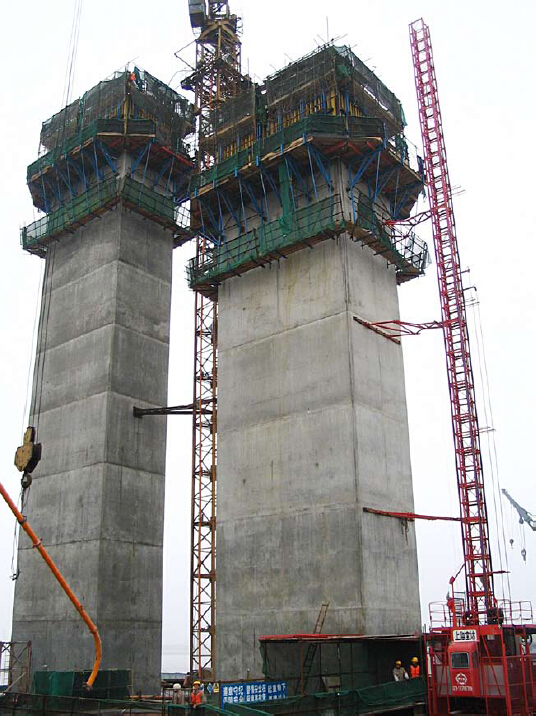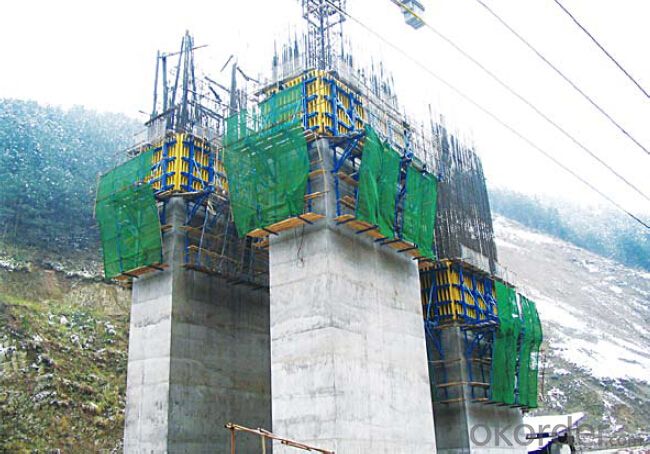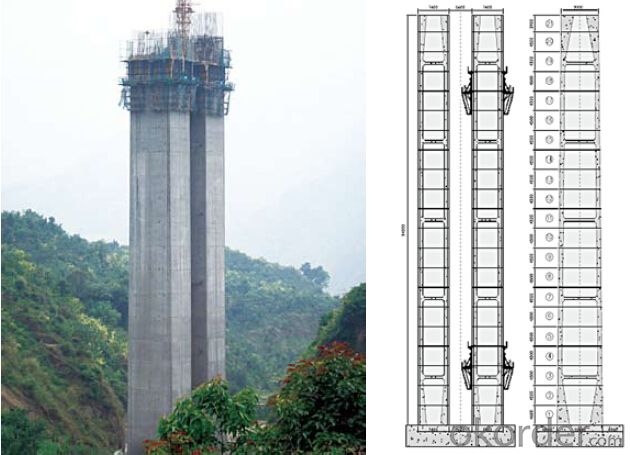Climbing bracket CB240 for formwork and scaffolding system
- Loading Port:
- Tianjin
- Payment Terms:
- TT OR LC
- Min Order Qty:
- 50 m²
- Supply Capability:
- 1000 m²/month
OKorder Service Pledge
OKorder Financial Service
You Might Also Like
Climbing Bracket CB240 & CB210
They are framework brackets for supporting large-area wall formwork.
Typical applications for the CB240&CB210 are pier and column/shear wall/core walll/ in the
building.
CB210 has smaller size than CB240, it will be cost effective in some condition.
Characteristics:
◆ High bearing capacity
The high loading capacity of the brackets allow very large scaffold units. This saves the number
anchor points required as well as reducing climbing times.
◆ Simple moving procedure by crane
Through the strong connection of formwork together with the climbing scaffold, both can be moved
as a single climbing unit by crane. Thus valuable time-savings can be achieved.
◆ Fast striking process without a crane
With the retrusive set, large formwork elements can also be retracted quickly and a minimum of
effort.
◆ Safe with work platform
The platforms have assembled firmly with bracket and will be climbing together, without scaffolding
but can work safely in spite of your high location.


- Q: What are the advantages and disadvantages of the application of the steel formwork and the plywood formwork in the construction?
- From the aspect of Construction: the construction speed of the large steel formwork is fast, the quality effect is good; the wood formwork is assembled slowly, and the bulging phenomenon is easy to occur;
- Q: How does steel formwork affect the overall project cost estimation?
- Steel formwork can have a significant impact on the overall project cost estimation. While it may have a higher upfront cost compared to traditional materials like wood or plywood, steel formwork offers several advantages that can help offset these initial expenses. Its durability and reusability make it a cost-effective choice in the long run as it eliminates the need for frequent replacements or repairs. Additionally, steel formwork enables faster construction times due to its strength and stability, reducing labor costs and potentially accelerating project timelines. Therefore, although steel formwork may contribute to higher upfront costs, it can ultimately lead to cost savings and efficiency improvements, positively impacting the overall project cost estimation.
- Q: What are the different types of supports used in steel formwork installation?
- Steel formwork installation commonly utilizes various types of supports to ensure stability and structural integrity. These supports are crucial for the formwork system, offering the following options: 1. Adjustable Props: These props effectively bear the weight of the formwork system and can be easily adjusted to the desired height. They provide stability during concrete pouring and curing. 2. Scaffolding: Frequently employed in steel formwork installation, scaffolding serves as a stable platform for workers. It allows easy assembly and disassembly, making it highly adaptable to different construction projects. 3. Beams and Girders: These horizontal supports distribute load evenly, preventing excessive deflection or deformation of the steel formwork. 4. Bracing: To maintain stability during concrete pouring and curing, diagonal supports known as bracing prevent lateral movement and secure the formwork in place. 5. Anchors and Tie Rods: Anchors and tie rods secure the formwork system to the existing structure, providing additional support and preventing movement or displacement during concrete pouring. 6. Wall Ties: Wall ties hold the formwork panels together, offering lateral support. Typically made of steel, they withstand concrete pressure during pouring and curing. 7. Wedges and Clamps: Wedges and clamps ensure a secure fit of the formwork panels, preventing concrete leakage during pouring. The appropriate selection of support for steel formwork installation depends on factors like structure size, complexity, load-bearing capacity, and site conditions. It is crucial to carefully consider these factors to ensure a safe and efficient formwork installation process.
- Q: How does steel formwork handle concrete bleeding?
- Steel formwork is a highly effective choice for managing concrete bleeding, which occurs when water in the concrete mixture rises to the surface and separates from the solid components. With its smooth and non-porous surface, steel formwork is designed to prevent excessive bleeding and water loss from the concrete mixture. The tight joints and connections of steel formwork further reduce the chances of water seepage, ensuring that the concrete retains its desired water content. Furthermore, steel formwork offers exceptional support and stability during the pouring and setting process, preventing the formation of voids or gaps within the concrete and reducing the risk of excessive bleeding. Its rigidity also helps maintain the concrete's shape and structure, preventing any deformation or cracking caused by bleeding. Moreover, steel formwork allows for easy and efficient removal of excess water from the concrete surface. Its smooth and non-absorbent nature facilitates various techniques, such as squeegeeing or vacuuming, to remove the excess water and minimize the bleeding effect. In conclusion, steel formwork effectively manages concrete bleeding through its smooth and non-porous surface, minimized water seepage, stability, and support to the concrete, and efficient removal of excess water.
- Q: Can steel formwork be used for different types of concrete finishes?
- Yes, steel formwork can be used for different types of concrete finishes. Steel formwork is highly versatile and can be customized to create various concrete finishes such as smooth, textured, or patterned surfaces. The steel formwork allows for precise shaping and molding of the concrete, enabling the creation of different finishes according to the desired design and aesthetic requirements. Additionally, steel formwork can be easily adjusted and reused for different projects, making it a cost-effective choice for achieving diverse concrete finishes.
- Q: What is the maximum concrete pressure that steel formwork can withstand?
- The maximum concrete pressure that steel formwork can withstand varies depending on several factors, including the specific design and construction of the formwork system. However, in general, steel formwork is capable of withstanding higher concrete pressures compared to other types of formwork materials. The maximum concrete pressure that steel formwork can withstand typically ranges from 50 to 100 kilonewtons per square meter (kN/m²) or 7.2 to 14.4 pounds per square inch (psi). This level of pressure is well-suited for a wide range of construction projects, including high-rise buildings, bridges, and other structures that require heavy concrete pours. It is important to note that the maximum concrete pressure that steel formwork can withstand should always be determined by a qualified engineer or designer. They will consider factors such as the height and thickness of the concrete pour, the spacing and size of the formwork supports, and the strength and stability of the steel formwork system. By adhering to the recommended maximum concrete pressure limits, construction professionals can ensure the safety and integrity of the formwork system, minimize the risk of failure or collapse, and achieve a successful concrete pour.
- Q: Can steel formwork be used in precast concrete applications?
- Yes, steel formwork can be used in precast concrete applications. Steel formwork is commonly used in precast concrete construction as it offers durability, strength, and the ability to create complex shapes and designs. It provides a reliable and efficient solution for creating precise and high-quality precast concrete elements.
- Q: What are the different cost considerations associated with steel formwork?
- There are several cost considerations associated with steel formwork that need to be taken into account when planning a construction project. Firstly, there is the initial cost of purchasing or renting the steel formwork. Steel formwork is generally more expensive than other types of formwork, such as timber or plastic. However, it is important to note that steel formwork is durable and has a longer lifespan, which can offset the initial cost in the long run. Secondly, there are the labor costs associated with assembling and dismantling the steel formwork. Steel formwork requires skilled labor for proper installation and removal, which may incur additional expenses. However, steel formwork is typically faster to set up and dismantle compared to other types of formwork, which can potentially reduce labor costs. Another cost consideration is the maintenance and repair expenses. While steel formwork is known for its durability, it may still require occasional maintenance or repairs to ensure its optimal performance. This can include cleaning, painting, or replacing damaged components. These maintenance costs should be factored into the overall project budget. Additionally, transportation costs should be considered when using steel formwork. Steel formwork is heavy and bulky, requiring special transportation arrangements. This can lead to higher transportation costs compared to lighter and more compact formwork options. Lastly, the cost of formwork accessories, such as connectors, brackets, and ties, should also be taken into account. These accessories are necessary for proper formwork installation and can add to the overall cost of using steel formwork. In conclusion, the different cost considerations associated with steel formwork include the initial purchase or rental cost, labor costs for assembly and dismantling, maintenance and repair expenses, transportation costs, and the cost of formwork accessories. While steel formwork may have higher upfront costs, its durability, speed of installation, and long-term lifespan can provide cost-saving benefits in the long run.
- Q: Are there any disadvantages to using steel formwork?
- Using steel formwork does have its drawbacks. One major disadvantage is the steep initial cost associated with it. Compared to other formwork options like wood or plastic, steel formwork is pricier to purchase or rent. This can pose a significant challenge for smaller construction projects or contractors operating on a tight budget. Another drawback lies in the weight of steel formwork. It is considerably heavier than alternative materials, making it more difficult to handle and transport. This can result in increased labor costs and a greater need for manpower when setting up or dismantling the formwork. Moreover, assembling and dismantling steel formwork requires skilled labor. It is crucial to have experienced workers who possess the knowledge of correct procedures and techniques to ensure the safety and stability of the formwork. This, in turn, can contribute to higher project costs and extended timelines. Steel formwork is also susceptible to corrosion if not properly maintained. Exposure to moisture and chemicals can lead to rust and deterioration, compromising the formwork's integrity and posing safety risks. Regular inspections and maintenance are necessary to prevent and address corrosion issues. Lastly, steel formwork lacks the flexibility and adjustability found in other types of formwork. Once it is fabricated, it becomes difficult to modify or adjust to accommodate changes in design or dimensions. This inflexibility can be a disadvantage in projects where modifications or adjustments are frequently required. In conclusion, while steel formwork does offer advantages such as durability and reusability, it is important to consider its disadvantages when selecting the appropriate formwork for a construction project.
- Q: How does steel formwork handle concrete vibration and air entrapment?
- Steel formwork is highly effective in handling concrete vibration and minimizing air entrapment during the pouring and curing process. Firstly, steel formwork is known for its high strength and rigidity, which allows it to withstand the intense vibrations caused by concrete compaction. When concrete is poured into steel formwork, the formwork itself acts as a barrier, preventing excessive movement or deformation that could lead to the formation of voids or air pockets. This ensures that the concrete is evenly distributed and compacted throughout the structure. Additionally, steel formwork is designed with tight joints and smooth surfaces, which helps in reducing air entrapment. The joints are tightly sealed to prevent any leakage, which could result in air being trapped within the concrete. This is particularly important as air pockets can weaken the structural integrity and durability of the concrete. The smooth surfaces also aid in the easy flow and consolidation of the concrete, reducing the chances of air entrapment. Furthermore, steel formwork can be easily customized and adjusted to fit the specific requirements of the construction project. This allows for precise and accurate placement of the formwork, ensuring that the concrete is poured and compacted in the desired manner. By having complete control over the formwork, the risk of air entrapment can be minimized, resulting in a more durable and reliable concrete structure. In conclusion, steel formwork is an excellent choice for handling concrete vibration and air entrapment. Its strength, rigidity, tight joints, and smooth surfaces provide the necessary stability and control during the pouring and compaction process. By using steel formwork, construction professionals can ensure that the concrete is properly consolidated and free from air pockets, resulting in a high-quality and long-lasting structure.
Send your message to us
Climbing bracket CB240 for formwork and scaffolding system
- Loading Port:
- Tianjin
- Payment Terms:
- TT OR LC
- Min Order Qty:
- 50 m²
- Supply Capability:
- 1000 m²/month
OKorder Service Pledge
OKorder Financial Service
Similar products
Hot products
Hot Searches

















